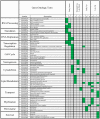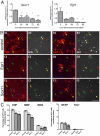Identification of a gene regulatory network necessary for the initiation of oligodendrocyte differentiation
- PMID: 21490970
- PMCID: PMC3072388
- DOI: 10.1371/journal.pone.0018088
Identification of a gene regulatory network necessary for the initiation of oligodendrocyte differentiation
Abstract
Differentiation of oligodendrocyte progenitor cells (OPCs) into mature oligodendrocytes requires extensive changes in gene expression, which are partly mediated by post-translational modifications of nucleosomal histones. An essential modification for oligodendrocyte differentiation is the removal of acetyl groups from lysine residues which is catalyzed by histone deacetylases (HDACs). The transcriptional targets of HDAC activity within OPCs however, have remained elusive and have been identified in this study by interrogating the oligodendrocyte transcriptome. Using a novel algorithm that allows clustering of gene transcripts according to expression kinetics and expression levels, we defined major waves of co-regulated genes. The initial overall decrease in gene expression was followed by the up-regulation of genes involved in lipid metabolism and myelination. Functional annotation of the down-regulated gene clusters identified transcripts involved in cell cycle regulation, transcription, and RNA processing. To define whether these genes were the targets of HDAC activity, we cultured rat OPCs in the presence of trichostatin A (TSA), an HDAC inhibitor previously shown to inhibit oligodendrocyte differentiation. By overlaying the defined oligodendrocyte transcriptome with the list of 'TSA sensitive' genes, we determined that a high percentage of 'TSA sensitive' genes are part of a normal program of oligodendrocyte differentiation. TSA treatment increased the expression of genes whose down-regulation occurs very early after induction of OPC differentiation, but did not affect the expression of genes with a slower kinetic. Among the increased 'TSA sensitive' genes we detected several transcription factors including Id2, Egr1, and Sox11, whose down-regulation is critical for OPC differentiation. Thus, HDAC target genes include clusters of co-regulated genes involved in transcriptional repression. These results support a de-repression model of oligodendrocyte lineage progression that relies on the concurrent down-regulation of several inhibitors of differentiation.
Conflict of interest statement
Figures






Similar articles
-
Histone deacetylase activity is necessary for oligodendrocyte lineage progression.J Neurosci. 2002 Dec 1;22(23):10333-45. doi: 10.1523/JNEUROSCI.22-23-10333.2002. J Neurosci. 2002. PMID: 12451133 Free PMC article.
-
Histone deacetylase activity is required for human oligodendrocyte progenitor differentiation.Glia. 2012 Dec;60(12):1944-53. doi: 10.1002/glia.22410. Epub 2012 Aug 23. Glia. 2012. PMID: 22927334
-
E2F1 coregulates cell cycle genes and chromatin components during the transition of oligodendrocyte progenitors from proliferation to differentiation.J Neurosci. 2014 Jan 22;34(4):1481-93. doi: 10.1523/JNEUROSCI.2840-13.2014. J Neurosci. 2014. PMID: 24453336 Free PMC article.
-
From OPC to Oligodendrocyte: An Epigenetic Journey.Cells. 2019 Oct 11;8(10):1236. doi: 10.3390/cells8101236. Cells. 2019. PMID: 31614602 Free PMC article. Review.
-
Molecular Control of Oligodendrocyte Development.Trends Neurosci. 2019 Apr;42(4):263-277. doi: 10.1016/j.tins.2019.01.002. Epub 2019 Feb 12. Trends Neurosci. 2019. PMID: 30770136 Free PMC article. Review.
Cited by
-
Lysophosphatidic acid signaling via LPA6 : A negative modulator of developmental oligodendrocyte maturation.J Neurochem. 2022 Dec;163(6):478-499. doi: 10.1111/jnc.15696. Epub 2022 Oct 18. J Neurochem. 2022. PMID: 36153691 Free PMC article.
-
Chronic oligodendrogenesis and remyelination after spinal cord injury in mice and rats.J Neurosci. 2015 Jan 21;35(3):1274-90. doi: 10.1523/JNEUROSCI.2568-14.2015. J Neurosci. 2015. PMID: 25609641 Free PMC article.
-
Mechano-modulation of nuclear events regulating oligodendrocyte progenitor gene expression.Glia. 2019 Jul;67(7):1229-1239. doi: 10.1002/glia.23595. Epub 2019 Feb 8. Glia. 2019. PMID: 30734358 Free PMC article. Review.
-
Neuregulin and BDNF induce a switch to NMDA receptor-dependent myelination by oligodendrocytes.PLoS Biol. 2013 Dec;11(12):e1001743. doi: 10.1371/journal.pbio.1001743. Epub 2013 Dec 31. PLoS Biol. 2013. PMID: 24391468 Free PMC article.
-
Impact of Histone Acetyltransferases and Histone Deacetylases on Adult Brain Myelin Plasticity.Results Probl Cell Differ. 2025;75:213-246. doi: 10.1007/978-3-031-91459-1_8. Results Probl Cell Differ. 2025. PMID: 40593212 Review.
References
-
- Baumann N, Pham-Dinh D. Biology of oligodendrocyte and myelin in the mammalian central nervous system. Physiol Rev. 2001;81:871–927. - PubMed
-
- Gielen E, Baron W, Vandeven M, Steels P, Hoekstra D, et al. Rafts in oligodendrocytes: evidence and structure-function relationship. Glia. 2006;54:499–512. - PubMed
Publication types
MeSH terms
Grants and funding
LinkOut - more resources
Full Text Sources
Other Literature Sources
Molecular Biology Databases
Research Materials

